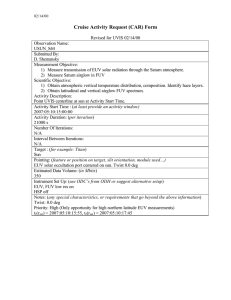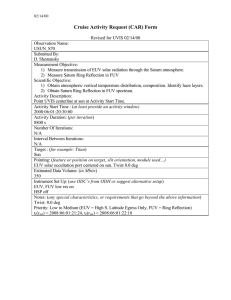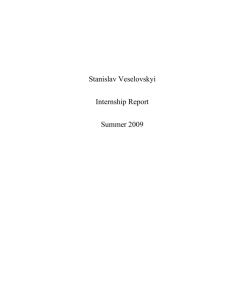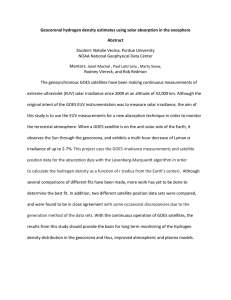Preparation, Storage, Characterization and Use of Two-surface Reflectance Standards
advertisement
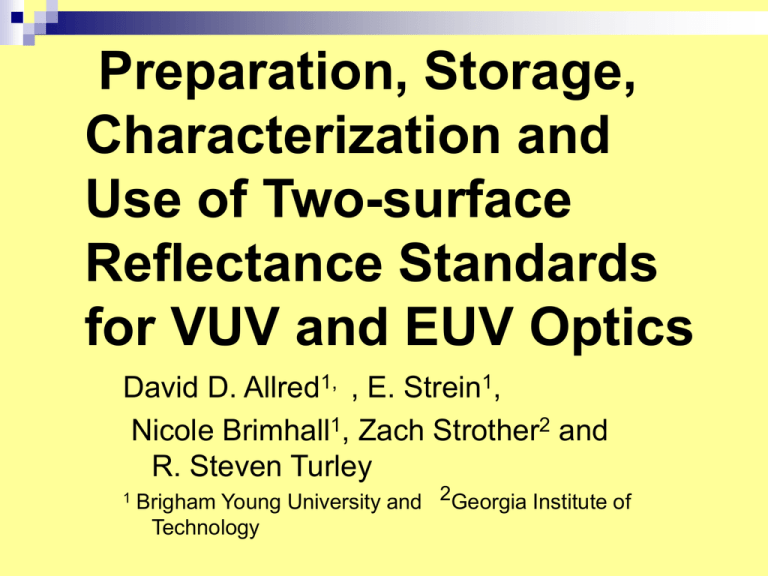
Preparation, Storage, Characterization and Use of Two-surface Reflectance Standards for VUV and EUV Optics David D. Allred1, , E. Strein1, Nicole Brimhall1, Zach Strother2 and R. Steven Turley 1 Brigham Young University and 2Georgia Institute of Technology IMAGE Extreme Ultraviolet Imager http://euv.lpl.arizona.edu/euv/index.html IMAGE Extreme Ultraviolet Imager Earth's plasmasphere at 30.4 nm. This image from the Extreme Ultraviolet Imager was taken at 07:34 UTC on 24 May 2000, at a range of 6.0 Earth radii from the center of Earth and a magnetic latitude of 73 N. The Sun is to the lower right, and Earth's shadow extends through the plasmasphere toward the upper left. The bright ring near the center is an aurora, and includes emissions at wavelengths other than 30.4 nm. (From Sandel, B. R., et al., Space Sci. Rev., 109, 25, 2003.) HeII is singly ionized He. Trapped in the Earth’s Magnetosphere it scatters light from sun’s corona due to 1s to 2p transition Reflecting at 30.4 & Antireflecting at 58.4 nm D.D. Allred, R. S. Turley, M. B. Squires, “Dual-function EUV multilayer mirrors for the IMAGE mission,” in EUV, X-Ray and Neutron Optics and Courses, Carolyn A. Macdonald, Kenneth A. Goldberg, Juan R. Maldonado, H. Heather Chen-Mayer, Stephen P. Vernon, Editors, Proceedings of SPIE Vol. 3767, 280-287 (1999). pdf Our Goal – EUV Applications: there are scientists in China & US wanting Earth-observing Lunar. EUV Lithography Extreme Ultraviolet Optics has several applications. These Include: EUV Astronomy EUV Lithography EUV Astronomy Soft X-ray Microscopes A Better Understanding of materials for EUV applications is needed. The Earth’s magnetosphere in the EUV Soft X-ray Microscopes Introduction: Extreme Ultraviolet Optics and Optical Constants Two examples IMAGE satellite 2000 (above) ThO2 optical constants (right) Optical constants of compounds in the EUV are typically unknown, incomplete, or inaccurate. This can be important for those designing EUV optics for applications such as astronomy, lithography, or microscopy. BYU researchers have addressed the following concerns for those who would do some VUV/EUV (Vacuum/Extreme Ultraviolet) optics in a conventional laboratory as opposed to a large synchrotron facility: 1. Standards- Zach Strother (NSF-REU 07) 2. Mirror cleaning and storage. Liz Strein 3. Modeling 4. Sources/ spectrometers Standards: Desirable Qualities Robust Stable Cleanable Cheap Easy to Fabricate Easy to Characterize First studied is SiO2 on Si- that is (thermally oxidized Si) J. Tveekrem, “Contamination effects on EUV optics,” NASA Technical Report TP-1999-209264, 1999. Used with permission. Calculated reflectance for 41.3nm (30 eV) light on silicon 1 incident light reflected light 0.8 organic SiO2 Workers in x ray and EUV frequently measure from glancing angle as in figure. reflectance Si 0.6 0.4 0.2 0 0.1nm organic 0.1nm organic 1nm organic 0 0 5 5 10 10 15 15 20 20 25 25 30 30 35 35 40 40 angle (from grazing) E. Gullikson, X-Ray Interactions with Matter, http://henke.lbl.gov/optical_constants Accessed 27 Feb 2008. (calculated with the bilayer program) Outline of cleaning section Motivation: Dirt is clear in EUV Techniques/Methods: VUV lamp Results Instrumentation Excimer UV lamp (cleans samples) X-ray Photoelectron Spectrometer (XPS) Ellipsometer Evactron Plasma Cleaner (cleans XPS antechamber) Excimer Lamp Cleaning technique The excimer lamp creates ozone and atomic oxygen by exposing oxygen to 172nm photons. •These products oxidize the organic adventitious carbon on the samples thus freeing the SiO sample of its organic contamination 2 Adapted from http://ecl.web.psi.ch/NanoKat/Ni_Al2O3_ethanol_1.jpg O Ellipsometry Looks at how polarized light changes when it reflects from a surface. Used to determine the relative change in thickness for the “apparent oxide” on a sample “apparent oxide” layer organic SiO2 Si Substrate Adapted from http://users.aber.ac.uk/tej/ellipso5.gif Before excimer lamp Si 2p After excimer lamp Si 2p Correlation between characterization methods how the “apparent oxide” thickness decreases with exposure time Application to Source development Reflectance 0.02 0.018 69.74 eV dirty sample BYU measurement ALS 18 nm = 68.9 eV 0.016 Calc to 'match' ALS 0.014 Calc no dirt 0.012 0.01 0.008 0.006 0.004 0.002 0 20 25 30 35 40 45 angle from glancing (degr) 50 55 60 Comparison after cleanup 0.01 0.1 days stored 1 10 100 1000 29 y = 0.7592Ln(x) + 21.62 R2 = 0.7023 27 25 23 21 19 17 apparent oxide thickness 0.001 Take-home message of cleaning portion 5 min under lamp cleans off most of the last couple of angstroms of AC Correlation between characterization techniques (there are big problems when the characterization instruments change the nature of a sample) Cleanliness is important but can be achieved. Cleanup right before measurement is important. 69.74 eV dirty sample BYU measurement ALS 18 nm = 68.9 eV 0.02 0.018 0.016 Calc to 'match' ALS Reflectance 0.014 Calc no dirt 0.012 2.5 nm organic 0.01 calc for 68.9 eV (18 nm) 0.008 0.006 0.004 0.002 0 20 25 30 35 40 45 angle from glancing (degr) 50 55 60 Sources of EUV light Synchrotron Source Plasma Source High flux Wide, continuous wavelength range Not local, expensive to run, large footprint Fixed polarization Low Flux Wide wavelength range, only a few wavelengths in the range Local Unpolarized High Harmonics: femtosecond laser Fairly high flux Wide wavelength range, good spacing of wavelengths throughout the range Local Easily rotatable linear polarization Overview and Conclusions We have constructed an extreme ultraviolet (EUV) polarimeter that employs laser-generated high-order harmonics as the light source. This instrument represents a potential ‘in-house’ instrument at facilities developing EUV thin films. The source has high flux, a wavelength range from 8-62 nm, and easily rotatable linear polarization. The instrument has a versatile positioning system and can measure reflectance of multiple wavelengths of light simultaneously. We have compared reflectance data with that taken at the Advanced Light Source (ALS) and with calculated data. These measurements agree well. Introduction: Extreme Ultraviolet Optics and Optical Constants Two examples IMAGE satellite 2000 (above) ThO2 optical constants (right) Optical constants in the EUV are typically unknown, incomplete, or inaccurate. This is important for those designing EUV optics for applications such as astronomy, lithography, or microscopy. Optical Constants Optical constants are determined by measuring reflectance as a function of angle of a sample at a fixed wavelength and polarization, then fitting this data to the Fresnel equations. EUV light incident angle (Θ) sample Sources of EUV light Synchrotron Source Plasma Source High flux Wide, continuous wavelength range Not local, expensive to run, large footprint Fixed polarization Low Flux Wide wavelength range, only a few wavelengths in the range Local Unpolarized High Harmonics Fairly high flux Wide wavelength range, good spacing of wavelengths throughout the range Local Easily rotatable linear polarization High Harmonic Generation EUV Grating EUV Generation EUV Light 800nm,Wavelength range from 8-62 nm 30 fs, 10 mJ Flux of 6x108 photons/second Laser Pulses MCP Detector Easily rotatable linear polarization Gas (He, Ne, Ar) λ = 800 nm / q Orders 37 to 77 Wavelengths of 10-22 nm Fairly high flux Wide wavelength range with good spacing of wavelengths within the range Easily rotatable linear polarization Small footprint, low cost of operation Potential ‘in-house’ instrument at facilities developing EUV thin films Instrument Overview EUV generation f=100 cm focusing lens dual rotation stages turbo pumps secondary gas cell gas (He, Ne, Ar) sample 800 nm, 30 fs, 10 mJ laser pulses EUV grating rotatable half-wave plate aperture turbo pump turbo pump MCP CCD Easily rotatable linear polarization Ability to measure reflectance of multiple wavelengths simultaneously Extensive scanning ability Polarimeter Positioning System Linear Translation Grating Sample Secondary Vacuum Chamber MCP CCD camera Grating Rotation Turbo Pump Sample Rotation Detector Rotation MCP Rotation Linear Translation for Focusing The positioning system is made up of six motors, each controlled by a single computer. The diffraction grating is placed after the sample, allowing simultaneous reflectance measurements at multiple wavelengths. Controlled Harmonic Attenuator We increase the dynamic range of our detection system with a secondary gas cell that acts as a controlled harmonic attenuator. 90% 90% secondary gas cell 0.01% 0.01% Laser Power Discriminator Stability of our high harmonic source is important to the accuracy of polarimetry measurements. A sample of the incident laser beam is imaged in real time simultaneously with harmonics to provide per-shot energy monitoring Shot-to-shot variations in the laser pulse energy lead to about 37% variation in harmonic signal. Averaging 100 shots decreases variation to about 7%. To further increase repeatability, we implemented a laser energy discriminator, decreasing variations to about 2%. Reflectance Measurements Sample: High-harmonic generation parameters: thermally oxidized silicon, 27.4 nm SiO2 layer. 100 torr helium gas Measurement parameters: all measurements averaged over 100 shots where the variation in the laser power was +/-5% secondary gas cell pressures ranged in value from 0 to 2.8 torr (attenuation of about 3 orders of magnitude) dark signal taken simultaneously with measurements measurements taken on three separate days to examine possible systematics in repeatability. Compare Conclusions We have constructed a new instrument that uses high-order harmonics to measure optical properties of materials in the EUV. Our source has a wide wavelength range, high flux, and easily rotatable linear polarization. Our instrument has a sophisticated positioning system and is efficient in that simultaneous reflectance measurements can be made at multiple wavelengths. We have compared reflectance measurements with those taken at the ALS and computed data. These measurements agree. Future Work Investigate a new measurement technique In some regions where reflectance is very low, it may be difficult to measure absolute reflectance accurately (at near-normal angles, absolute reflectance is often on the order of 10-4). It may, however, be possible to measure a very accurate ratio of p- to spolarized reflectance. Our instrument has the capability to quickly toggle between polarizations to measure a very accurate ratio. Variation in the laser source or harmonic generation parameters over time scales longer than minutes will no longer be a concern. Also, dynamic range issues will no longer be a problem. Measure optical properties of materials in this wavelength range Optical constants Bonding effects on optical properties Oxidation rates Roughness effects Thank you We would like to recognize NSF grant PHY0457316 and Brigham Young University for supporting this project. High Harmonics: Schematic High Harmonics: Horizontal Wavelength Sorting Helium Gas Synchrotron vs. Polarimeter Data But there were some steps along the way: J. Tveekrem, “Contamination effects on EUV optics,” NASA Technical Report TP-1999-209264, 1999. Used with permission. Calculated reflectance for 41.3nm (30 eV) light on silicon 1 incident light reflected light 0.8 organic SiO2 reflectance Si 0.6 0.4 0.2 0 0.1nm organic 0.1nm organic 1nm organic 0 0 5 5 10 10 15 15 20 20 25 25 30 30 35 35 40 40 angle (from grazing) E. Gullikson, X-Ray Interactions with Matter, http://henke.lbl.gov/optical_constants Accessed 27 Feb 2008. (calculated with the bilayer program) Instrumentation X-ray Photoelectron Spectrometer (XPS) Ellipsometer Excimer UV lamp (cleans samples) Evactron Plasma Cleaner (cleans XPS antechamber) Excimer Lamp Cleaning technique The excimer lamp creates ozone and oxygen radicals by exposing oxygen to 172nm photons. •These products oxidize the organic adventitious carbon on the samples thus freeing the SiO sample of its organic contamination O 2 Adapted from http://ecl.web.psi.ch/NanoKat/Ni_Al2O3_ethanol_1.jpg Ellipsometry Looks at how polarized light changes when it reflects from a surface. Used to determine the relative change in thickness for the “apparent oxide” on a sample “apparent oxide” layer organic SiO2 Si Substrate Adapted from http://users.aber.ac.uk/tej/ellipso5.gif X-ray Photoelectron Spectroscopy (XPS) Detects the speed of electrons ripped off from a sample’s surface by x rays. Used to determine the chemical composition of a sample. http://www.almaden.ibm.com/st/scientific_services/materials_analysis/xps/XPS.gif Need for Evactron: Deposition rate on the samples exposed to the XPS antechamber Evactron C DeContaminator Plasma clean the XPS chamber http://www.evactron.com/63193/image2.gif Acknowledgements Amy Grigg Mike Keenlyside at Surface Physics Resonance LTD for the excimer lamp Gabe Morgan and Ron Vane for their loan of the Evactron C De-Contamination System Dr. Matt Linford Lei Pei The department of Physical and Mathematical Sciences for funding Storage data Storage time: 10 min to 19 days Most samples began with an apparent oxide layer ≤ 1.83nm 2.5 apparent oxide thickness (nm) 2.4 2.3 2.2 2.1 2 1.9 never exposed to chamber in chamber for < 1.5 min 1.8 1.7 0 5 10 15 days stored in air 20 Genetic Algorithm Genome Material Thickness Material Thickness Original Population Strong Performers become parents Strong Performers becomes parents Poor Performers discarded Poor Performers discarded etc. Paratt Recursion Polarization f s rsb rsa Ca 1 f s rsb S a Sb S a Sb S fs P nb2 S a na2 Sb fp 2 nb S a na2 Sb rpa Ca R ps rs p p rp 2 f p rpb 1 f p rpb 2 Modeled Reflectance: Mg(37)/a-C(5) 304 R Angle 584 a-C/Mg : S vs. P polarization P S Mg/a-C Barriers/Limitations a-C : variable optical and thickness properties based on deposition and origin. Mg : rapid oxidation complicates production, characterization of bilayer. Other potential Bilayer partners Fe, Ti – concerns about oxidation Ni – magnetic properties problematic for sputtering deposition Si – strong possibilities, models show many bilayers with strong interference peaks Modeled Reflectance: Si(46)/Ru(20) 304 R Angle 584 Ru/Si : S vs. P Polarization P S Si/SiO2 Si/SiO2 Conclusions Polarimeter allows for accurate EUV data collection in conventional laboratories a-C/Mg is optically effective but difficult to produce Si/Ru is optically effective, can be produced with single sputtering source SiO2 on Si wafer is a good, easily obtainable standard Acknowledgments NSF REU program at BYU summer 2007. Dept of Physics and Astronomy BYU Prof. R. Steven Turley, Joseph Muhlestein and Elise Martin for measurements at the ALS. Additional thanks to Eric Gullikson, Andrew Aquila and others at the ALS, and to the ALS for time on beamline 6.3.2. Prof. Justin Peatross, Prof. Michael Ware, Matthew Turner, and Nick Herrick for addition help in setting up the polarimeter.
